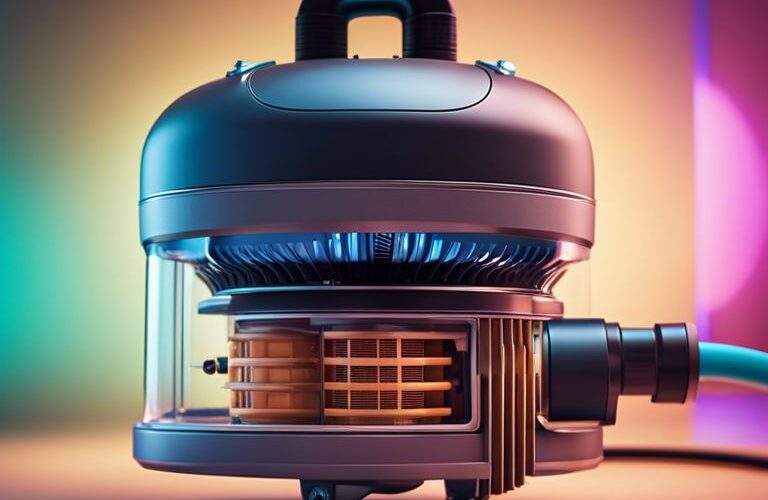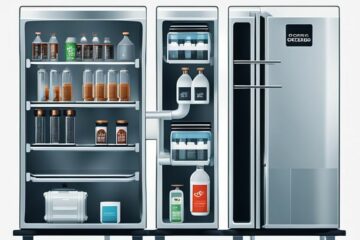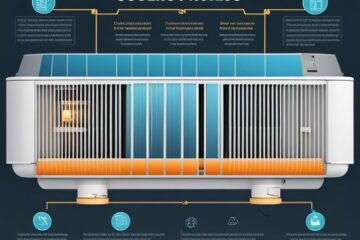With modern technology and engineering, vacuum cleaners have become imperative tools in maintaining clean and healthy indoor environments. These devices operate by creating a suction force that effectively removes dirt, dust, and debris from various surfaces. Vacuum cleaners work through a combination of mechanical and electrical components to efficiently clean different areas of homes or commercial spaces.
Key Takeaways:
- Suction power: Vacuum cleaners work by creating suction to pull dirt and debris into the machine.
- Airflow: The vacuum cleaner’s motor powers a fan that creates airflow, sucking in air along with dirt particles.
- Filtration: Many vacuum cleaners have filters to trap dust and allergens, preventing them from circulating back into the air.
- Brushes and agitators: These components help loosen and dislodge dirt from carpets and upholstery, making it easier for the vacuum to pick up.
- Dirt collection: Dirt and debris are collected in a bag or canister that can be easily emptied and cleaned.
- Attachments: Vacuum cleaners often come with various attachments for cleaning different surfaces and hard-to-reach areas.
- Maintenance: Regular maintenance, such as cleaning or replacing filters and emptying containers, is important to keep the vacuum cleaner working efficiently.
Fundamentals of Vacuum Cleaners
Basic Concept of Suction
If you’ve ever wondered how a vacuum cleaner is able to suck up dirt and debris from your floors, the answer lies in the basic concept of suction. Suction is created by a motor that powers a fan or impeller inside the vacuum cleaner. As the fan spins, it creates a low-pressure area inside the vacuum cleaner, causing air to rush in from the surrounding environment. This rush of air carries dirt and debris along with it, which is then collected in the vacuum cleaner’s dust bag or canister.
Importance of Air Flow in Vacuum Cleaners
Fundamentally, airflow is crucial in the cleaning process of a vacuum cleaner. The faster the air moves through the vacuum cleaner, the more effectively it can pick up dirt and debris from surfaces. Proper airflow ensures that debris is carried through the vacuum cleaner and into the dust bag or canister, rather than being left behind on the floor. Inadequate airflow can result in poor cleaning performance and leave your floors still dirty after vacuuming.
Another vital aspect to consider is that optimal air flow also helps prevent the motor from overheating. When the air can move freely through the vacuum cleaner, it helps to dissipate heat generated by the motor, protecting the vacuum cleaner from damage and ensuring its longevity.
Core Components of a Vacuum Cleaner
The Electric Motor
An crucial component of a vacuum cleaner is the electric motor. An electric motor drives the fan and creates the suction power needed to lift dirt and debris off surfaces. The motor in a vacuum cleaner is specially designed to be powerful yet compact, allowing for efficient operation without taking up too much space.
The Fan
Cleaner : What sets a vacuum cleaner apart from a simple tube sucking up dirt is its fan. The fan is responsible for creating airflow within the vacuum, sucking in air along with dirt and dust particles. The design of the fan ensures that the air is propelled with enough force to pick up debris from various surfaces.
Another critical component of a vacuum cleaner is the filters. Filters play a crucial role in trapping dust and preventing it from circulating back into the air. Different types of filters, such as HEPA filters, are used to ensure that the air expelled from the vacuum is clean and free of allergens.
The Dust Bag or Canister
One of the most recognizable parts of a vacuum cleaner is the dust bag or canister where all the dirt and debris are collected. A dust bag acts as a containment unit, preventing dust from escaping back into the air while vacuuming. Canisters, on the other hand, offer a transparent view of the collected debris for easier monitoring.
On average, a vacuum cleaner’s dust bag or canister needs to be emptied once it reaches about two-thirds full. Regular maintenance of this component is crucial to ensure optimal suction power and prevent dust buildup that could affect the machine’s performance.
The Housing Unit
This part of the vacuum cleaner encapsulates and protects all the internal components. Motor housing units are typically made of durable materials like plastic or metal to withstand the stresses of regular use. The housing unit also contains the controls and filters, making it a central part of the vacuum’s structure.
Types of housing units can vary from upright to canister models, each offering unique advantages in terms of maneuverability, storage, and overall cleaning performance. It is important to choose a vacuum cleaner with a housing unit that suits your specific needs and preferences.
Types of Vacuum Cleaners
Now, let’s explore the different types of vacuum cleaners available in the market. Understanding the various options will help you choose the best one that suits your cleaning needs.
- Upright Vacuum Cleaners: Upright vacuum cleaners are the most common type and are known for their powerful suction capabilities. They are ideal for deep cleaning carpets and large areas. Upright vacuums have a motor and suction head in a single unit, making them easy to maneuver. They typically come with adjustable height settings for different floor types and often include attachments for cleaning upholstery and crevices.
Canister Vacuum Cleaners
Vacuum cleaners with a separate canister for the motor and dust collection are known as canister vacuum cleaners. These models are versatile and excel at cleaning hard-to-reach places such as under furniture and stairs. The canister design allows for a lighter vacuum head, making it easier to maneuver. Canister vacuums come with a variety of attachments for specialized cleaning tasks, such as dusting blinds or vacuuming curtains.
Canister vacuum cleaners are a popular choice for those who prioritize flexibility and precision in their cleaning routine. The separate canister also means that these vacuums tend to have a larger dust capacity compared to upright models. Additionally, the hose and wand attachments make it easier to clean above-floor surfaces like ceilings and shelves.
Stick and Handheld Vacuum Cleaners
Vacuum cleaners designed for quick clean-ups and spot cleaning are categorized as stick and handheld vacuum cleaners. These models are lightweight, compact, and easy to use for small messes or reaching tight spaces. Stick vacuums are popular for their slim design, making them convenient for storing in small spaces like closets or pantry corners.
Stick and handheld vacuum cleaners are great for maintaining a clean home in between deep cleaning sessions. They are handy for vacuuming pet hair off furniture, cleaning up crumbs in the kitchen, or reaching cobwebs in corners. Some models even offer cordless options for added convenience.
Robotic Vacuum Cleaners
One of the latest innovations in the world of vacuum cleaners is robotic vacuum cleaners. These automated devices move around your home independently, using sensors to navigate and clean floors. Robotic vacuums can be programmed to operate on a schedule, allowing for hands-free cleaning while you focus on other tasks.
Robotic vacuum cleaners are ideal for busy individuals or those who want to maintain a clean home with minimal effort. While they may not have the same suction power as traditional vacuums, they excel at daily maintenance cleaning. Some models can even be controlled remotely via smartphone apps, providing added convenience.
Wet/Dry Vacuum Cleaners
Vacuum cleaners designed to handle both wet and dry messes are referred to as wet/dry vacuum cleaners. These versatile models are equipped with specialized filters and tanks that allow them to vacuum liquids as well as dirt and debris. Wet/dry vacuums are particularly useful for cleaning up spills, wet debris, or even unclogging drains.
Wet/dry vacuum cleaners are a valuable tool to have in your cleaning arsenal, especially in areas prone to moisture or frequent spills. The ability to switch between wet and dry cleaning modes makes these vacuums suitable for various cleaning tasks, from cleaning up after a plumbing mishap to tidying up a dusty workshop.
The Vacuuming Process
The Role of the Intake Port
All vacuum cleaners have a common starting point for the vacuuming process – the intake port. This opening is where dirt, dust, and debris are drawn in by the suction power of the vacuum. It serves as the gateway through which all particles enter the vacuum cleaner for collection.
Path of the Airflow
All vacuum cleaners are designed with a specific path for airflow to follow. Once the dirt and debris enter through the intake port, they travel through a series of filters and into the dust collection bag or canister. The design of the vacuum ensures that airflow is maintained at an optimal level to effectively capture and contain particles.
Plus, understanding the path of airflow in a vacuum cleaner is imperative for proper maintenance and troubleshooting. Any blockages or leaks in the airflow path can significantly reduce the effectiveness of the vacuum cleaner and potentially lead to overheating or damage to the motor.
Adjustments for Different Surfaces
Adjustments for different surfaces are often found on modern vacuum cleaners to enhance cleaning performance. These adjustments can include varying the height of the vacuum head to accommodate different carpet lengths or switching between brushes for hard floors versus carpets. By making these adjustments, users can optimize the vacuum cleaner’s efficiency based on the specific surface being cleaned.
Airflow is a critical component of the vacuuming process, as it is responsible for carrying dirt and debris from the intake port to the dust collection area. Maintaining a strong and consistent airflow is imperative for thorough cleaning and preventing particles from escaping back into the air. It is important to regularly clean or replace filters and empty dust collection bags to ensure proper airflow and a well-functioning vacuum cleaner.
Additional Features and Attachments
Brushes and Powerheads
Powerheads are motorized attachments that help to deep clean carpets and rugs by agitating the fibers and lifting dirt and debris. These tools are imperative for homes with carpeted floors as they provide a thorough cleaning that a standard vacuum head may not achieve. The motorized brush roll in the powerhead helps to dislodge stubborn dirt and pet hair, leaving your carpets looking fresh and clean.
Crevice Tools and Extension Wands
Crevice tools are long, narrow attachments that are perfect for cleaning tight spaces such as between couch cushions, along baseboards, and in car interiors. Extension wands allow you to reach high ceilings, ceiling fans, and light fixtures without having to strain or use a ladder. These tools are versatile and can help you achieve a comprehensive clean in all areas of your home.
For hard-to-reach spots and areas that require precision cleaning, crevice tools and extension wands are invaluable. They allow you to access corners, crevices, and high places with ease, ensuring no dust or dirt is left behind.
Upholstery Tools
On upholstery tools, such as brush attachments or fabric-specific nozzles, are designed to gently clean sofas, chairs, and other fabric surfaces without causing damage. These tools help to suction up dirt, dust, and pet hair from upholstery, leaving them looking refreshed and clean.
For instance, if your vacuum cleaner comes with an upholstery tool, you can easily switch between cleaning your floors and furniture without any hassle. These attachments are designed to provide a gentle yet effective clean for your delicate upholstery.
HEPA Filters and Other Specialized Features
Tools equipped with HEPA filters are a great choice for those with allergies or respiratory issues as they can trap small particles and allergens, preventing them from being released back into the air. Other specialized features like adjustable suction settings, automatic cord rewind, and LED headlights can make vacuuming easier and more efficient.
The inclusion of HEPA filters in vacuums is a significant advantage for those concerned about indoor air quality. These filters can capture microscopic particles such as dust mites, pollen, and pet dander, making your home a cleaner and healthier environment. The additional features like adjustable settings and automatic cord rewind enhance the overall user experience and efficiency of the vacuum cleaner.
Maintenance and Troubleshooting
Regular Maintenance Tips
Many people underestimate the importance of regular maintenance for their vacuum cleaner. Proper maintenance not only ensures the longevity of your appliance but also maintains its optimal performance. With just a few simple steps, you can keep your vacuum cleaner in top condition. Remember to clean the filters regularly to prevent clogs and to empty the dustbin after each use. Check for blockages in the hose and brushroll, and replace bags or empty the canister when full. Any signs of wear and tear should be addressed promptly to avoid further damage.
Common Vacuum Cleaner Problems
Common vacuum cleaner problems can disrupt your cleaning routine and leave your floors dirty. Plus, they can be frustrating to deal with. Issues like loss of suction, unusual noises, brushroll not spinning, or overheating are among the most encountered problems. It is crucial to diagnose the issue promptly and address it accordingly. If you are experiencing any of these issues, consult the user manual for troubleshooting tips or seek professional help if needed.
Tips for Longevity and Optimal Performance
With proper care and maintenance, your vacuum cleaner can last for years while delivering optimal performance. Remember to clean the brushroll regularly to prevent it from getting clogged with hair and debris. Vacuum on a regular basis to prevent dirt buildup and reduce strain on the motor. Thou should also store your vacuum properly in a clean, dry area to prevent dust and dirt from accumulating.
Vacuum cleaners are an imperative household appliance, but they require regular attention and care to maintain their efficiency. By following these tips for longevity and optimal performance, you can ensure that your vacuum cleaner operates at its best for years to come. Thou should also consider scheduling regular maintenance checks with a professional to address any potential issues before they escalate.
Motor
The motor is the heart of a vacuum cleaner, responsible for generating suction and powering the brushroll. It is important to keep the motor clean and free of debris to prevent overheating and damage. Regularly check for any unusual odors, noises, or decreased suction power, as these could indicate motor issues. If you notice any of these signs, it is crucial to address them promptly to avoid further damage to the motor.
Impact of Vacuum Cleaners on Health and Environment
Allergen Removal and Air Quality
Once again, it is important to acknowledge the significant impact vacuum cleaners have on both our health and the environment. The removal of allergens such as dust, pet dander, and pollen plays a crucial role in improving indoor air quality. High-efficiency particulate air (HEPA) filters in modern vacuum cleaners are designed to trap small particles, preventing them from being released back into the air during cleaning.
Disposal of Vacuum Bags and Environmental Concerns
Disposal of vacuum bags and the environmental impact of vacuum cleaner use are also important considerations. The proper disposal of vacuum bags ensures that the captured dirt, dust, and debris do not contribute to air and surface pollution. However, certain vacuum bags may contain non-biodegradable materials that can have long-lasting effects on the environment if not disposed of correctly.
Cleaners should be aware of the type of vacuum bags they are using and follow local guidelines for disposal to minimize environmental harm. Recycling options for vacuum bags may be available in some areas, providing a more sustainable solution for waste management.
To wrap up
Ultimately, a vacuum cleaner works by creating a powerful suction force that sucks in air and debris through the nozzle. Once inside, the air and particles pass through a series of filters that trap the dirt while allowing the air to flow through. The filtered air is then expelled back into the room, leaving behind a cleaner space.
Understanding the basic principles of how a vacuum cleaner operates can help users maintain and troubleshoot their devices effectively. By regularly emptying the dustbin, cleaning or replacing filters, and checking for any clogs in the system, users can ensure that their vacuum cleaner continues to work efficiently and effectively for years to come.
FAQ
Q: How does a vacuum cleaner create suction?
A: A vacuum cleaner creates suction through a motor-powered fan that pulls air and dust particles into the machine.
Q: What is the role of the motor in a vacuum cleaner?
A: The motor in a vacuum cleaner powers the fan which creates the suction necessary to remove dirt and debris from surfaces.
Q: How does the vacuum cleaner’s filtration system work?
A: The filtration system in a vacuum cleaner traps dust and dirt particles in a filter or dust bag, allowing clean air to be released back into the environment.
Q: What is the purpose of the rotating brush in a vacuum cleaner?
A: The rotating brush, also known as the beater bar, agitates carpet fibers and helps loosen dirt for easier suction and removal.
Q: How does a vacuum cleaner handle different floor surfaces?
A: Vacuum cleaners have height adjustments and different attachments to accommodate various floor surfaces such as carpets, hardwood, tile, and rugs.
Q: What is the function of the dust bag or dirt container in a vacuum cleaner?
A: The dust bag or dirt container collects the debris and dust sucked up by the vacuum, allowing for easy disposal and maintenance.
Q: How does the power cord in a vacuum cleaner affect its performance?
A: The length and quality of the power cord can impact the reach and efficiency of a vacuum cleaner, so it’s important to consider these factors when choosing a model.









